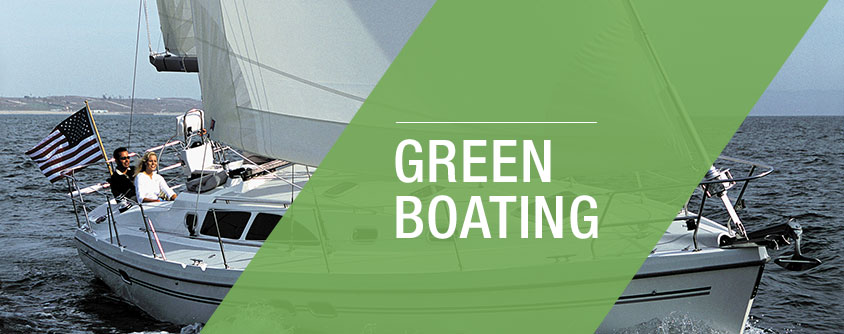
TOP TIPS FOR GREENER BOATING
-
USE SAFE PRODUCTSLook for the EPA-Certified “Design for the Environment” DfE label, which quickly identifies cleaning products recognized by the EPA as safer for people and the environment. Use legal anti-fouling bottom paints and biodegradable cleaning agents when prepping and bottom painting your boat; be sure paint or cleansers do not enter the water. Be mindful of EPA rules for bottom painting, recovery of hull cleaning and rinse water, and pressure blasting materials. To find environmentally responsible boat cleaning products, search Green Seal’s database of ‘Green Seal Certified’ products at www.greenseal.org.
-
MAINTAIN EQUIPMENT PROPERLYBe sure your engine reaches its correct wide-open-throttle RPM by choosing a prop with the right pitch. Adjustablepitch propellers and modular props help your boat run efficiently and ultimately reduce fuel consumption. Make sure your boat, engine and propeller blades are in good condition and are properly maintained to avoid wasting fuel and minimize the chance of oil, gasoline or other hazardous materials entering the water.
-
PREVENT FUEL SPILLSUse or install a device to prevent overboard discharges from your tank vent. Such products work to recover spills when your tank is reaching its fuel capacity. Fill your tank slowly and leave it 10% empty to prevent overflows and give the fuel room to expand as it warms
-
STOW YOUR TRASHKeep your trash onboard: never throw cigarette butts, fishing line, or any other garbage into waterways. Take advantage of shore-side facilities to recycle plastic, glass, metal and paper. Recycle your winter storage shrink-wrap at local marinas, dealers and suppliers
-
RECYCLE YOUR WASTEDispose of paints, batteries, antifreeze, cleaning products, oil and other hazardous wastes at a waste collection facility when you return to land. 12V batteries are among the most recycled products in the world; many marine accessories stores offer a credit on a new battery when you return a used one. Never discharge your sewage when you are near the shore; for proper waste disposal, always use authorized pump-out stations or shore-side facilities. Check local rules and regulations for specific restrictions
-
MAINTAIN A CLEAN BILGEKeep your engine properly maintained and tuned to prevent fuel and oil leaks into the bilge. Use an oil-absorbent pad in your bilge and under the engine where drips can happen. Your regular boat maintenance routine should include bilge cleaning; consider using a bioremediation product to convert hydrocarbons into safer compounds.
-
CHART YOUR COURSEStudy waterways to prevent boat propellers from damaging sensitive sea floor habitats or injuring marine life. Plan your trip in advance to avoid confusion and misdirection which lead to excess fuel usage. Use an autopilot to help you navigate from one point to another more efficiently.
-
RECYCLE YOUR MONOFILAMENT FISHING LINEDiscarded fishing line is hazardous: It can entangle and kill marine birds and wildlife, and get caught in boat propellers and gear, resulting in potentially costly damage. Protect marine life and your fellow boaters by properly disposing of your monofilament fishing line. Many bait and tackle shops, marinas, fishing piers, marine accessories stores and boat ramps have monofilament recycling bins. A number of states have monofilament recycling initiatives; check with your state’s conservation or natural resources department.
-
PREVENT THE SPREAD OF AQUATIC INVASIVE SPECIESInvasive species are defined as those plants, animals, insects, etc. that are not native to a given region and whose introduction causes or is likely to cause economic or environmental damage or harm to human health. Aquatic invasive species (AIS) have become a problem nationwide by causing damage to aquatic ecosystems. Species of aquatic vegetation like Eurasion watermilfoil and freshwater mussels like the zebra or quagga mussels are examples of two species that can become attached to boat trailers after being in contaminated waterbodies. One way to help prevent the spread of AIS to new waterbodies is for recreational boat owners to make sure their boats and trailers are clean and free of any attached species after each use. Three simple steps should be implemented after each boating trip: Clean, Drain and Dry is the boaters way to help protect the environment from the damage that AIS can cause.Clean: all aquatic plants, animals and mud from your trailer and discard in trash. Rinse, scrub or pressure wash, as appropriate, away from storm drains, ditches or waterwaysDrain: any standing water that might become trapped within the structure of your trailer.Dry: your trailer between uses if possible before the next time it is used.By implementing these three easy steps, you can do your part to protect clean waterways.
-
GO GREEN IN MARINE ACCESSORIESChoose eco-friendly marine-grade products for routine maintenance and when you need to upgrade or replace your boat’s accessories. The number of products available that can help you be a good steward of the marine environment is steadily growing. For more information about green boating visit www.DiscoverBoating.com
GREEN BOATING
PRESERVING OUR WATERWAYS
Boaters and anglers are the original conservationists—they understand the importance of preserving our nation’s lakes, rivers, streams and coasts, because they experience them firsthand. The fees and taxes they pay pursuing their sport support sportfish restoration and government programs that protect the environment through the Clean Vessel Act and the Sport Fish Restoration and Boating Trust Fund. Marine engine manufacturers have invested billions of dollars to develop cleaner, more efficient engines—direct fuel injected (DFI) two-stroke engine technology and four-stroke engines and more recently catalyst and onboard emissions diagnostic systems for stern drive and inboard engines.
This brochure is published by NMMA for educational purposes only and it should not be assumed that all relevant safety information is included herein. NMMA makes no guarantee, representation or warranty, express or implied, at law or in equity, as to the validity, accuracy or sufficiency of the information included in this brochure. NMMA assumes no responsibility or liability for any injuries, claims, losses or damages arising in connection with the use of or reliance on the information included in this brochure.
POWERED BY 
